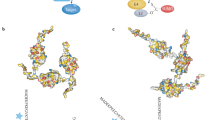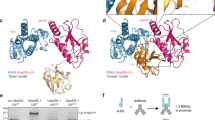Abstract
SUMOylation governs numerous cellular processes and is essential to most eukaryotic life. Despite increasing recognition of the importance of this process, an extremely limited number of small ubiquitin-like modifier (SUMO) protein ligases (E3s) have been identified. Here we show that at least some members of the functionally diverse tripartite motif (TRIM) superfamily are SUMO E3s. These TRIM proteins bind both the SUMO-conjugating enzyme Ubc9 and substrates and strongly enhance transfer of SUMOs from Ubc9 to these substrates. Among the substrates of TRIM SUMO E3s are the tumor suppressor p53 and its principal antagonist Mdm2. The E3 activity depends on the TRIM motif, suggesting it to be the first widespread SUMO E3 motif. Given the large number of TRIM proteins, our results may greatly expand the identified SUMO E3s. Furthermore, TRIM E3 activity may be an important contributor to SUMOylation specificity and the versatile functions of TRIM proteins.
This is a preview of subscription content, access via your institution
Access options
Subscribe to this journal
Receive 50 print issues and online access
$259.00 per year
only $5.18 per issue
Buy this article
- Purchase on Springer Link
- Instant access to full article PDF
Prices may be subject to local taxes which are calculated during checkout






Similar content being viewed by others
References
Bernardi R, Pandolfi PP . (2007). Structure, dynamics and functions of promyelocytic leukaemia nuclear bodies. Nat Rev Mol Cell Biol 8: 1006–1016.
Bernardi R, Scaglioni PP, Bergmann S, Horn HF, Vousden KH, Pandolfi PP . (2004). PML regulates p53 stability by sequestering Mdm2 to the nucleolus. Nat Cell Biol 6: 665–672.
Borden KL . (2002). Pondering the promyelocytic leukemia protein (PML) puzzle: possible functions for PML nuclear bodies. Mol Cell Biol 22: 5259–5269.
Cao T, Duprez E, Borden KL, Freemont PS, Etkin LD . (1998). Ret finger protein is a normal component of PML nuclear bodies and interacts directly with PML. J Cell Sci 111 (Pt 10): 1319–1329.
Chen L, Chen J . (2003). MDM2-ARF complex regulates p53 sumoylation. Oncogene 22: 5348–5357.
Dellaire G, Bazett-Jones DP . (2004). PML nuclear bodies: dynamic sensors of DNA damage and cellular stress. Bioessays 26: 963–977.
Deshaies RJ, Joazeiro CA . (2009). RING domain E3 ubiquitin ligases. Annu Rev Biochem 78: 399–434.
Duprez E, Saurin AJ, Desterro JM, Lallemand-Breitenbach V, Howe K, Boddy MN et al. (1999). SUMO-1 modification of the acute promyelocytic leukaemia protein PML: implications for nuclear localisation. J Cell Sci 112 (Pt 3): 381–393.
Geiss-Friedlander R, Melchior F . (2007). Concepts in sumoylation: a decade on. Nat Rev Mol Cell Biol 8: 947–956.
Gillot I, Matthews C, Puel D, Vidal F, Lopez P . (2009). Ret finger protein: An E3 ubiquitin ligase juxtaposed to the XY body in meiosis. Int J Cell Biol 2009: 524858.
Golebiowski F, Matic I, Tatham MH, Cole C, Yin Y, Nakamura A et al. (2009). System-wide changes to SUMO modifications in response to heat shock. Sci Signal 2: ra24.
Guo A, Salomoni P, Luo J, Shih A, Zhong S, Gu W et al. (2000). The function of PML in p53-dependent apoptosis. Nat Cell Biol 2: 730–736.
Hay RT . (2005). SUMO: a history of modification. Mol Cell 18: 1–12.
Hershko A, Ciechanover A . (1998). The ubiquitin system. Annu Rev Biochem 67: 425–479.
Hochstrasser M . (2001). SP-RING for SUMO: new functions bloom for a ubiquitin-like protein. Cell 107: 5–8.
Hoeller D, Hecker CM, Dikic I . (2006). Ubiquitin and ubiquitin-like proteins in cancer pathogenesis. Nat Rev Cancer 6: 776–788.
Johnson ES . (2004). Protein modification by SUMO. Annu Rev Biochem 73: 355–382.
Johnson ES, Gupta AA . (2001). An E3-like factor that promotes SUMO conjugation to the yeast septins. Cell 106: 735–744.
Kagey MH, Melhuish TA, Wotton D . (2003). The polycomb protein Pc2 is a SUMO E3. Cell 113: 127–137.
Kahyo T, Nishida T, Yasuda H . (2001). Involvement of PIAS1 in the sumoylation of tumor suppressor p53. Mol Cell 8: 713–718.
Kamitani T, Kito K, Nguyen HP, Wada H, Fukuda-Kamitani T, Yeh ET . (1998). Identification of three major sentrinization sites in PML. J Biol Chem 273: 26675–26682.
Lee MH, Lee SW, Lee EJ, Choi SJ, Chung SS, Lee JI et al. (2006). SUMO-specific protease SUSP4 positively regulates p53 by promoting Mdm2 self-ubiquitination. Nat Cell Biol 8: 1424–1431.
Meroni G, Diez-Roux G . (2005). TRIM/RBCC, a novel class of ‘single protein RING finger’ E3 ubiquitin ligases. Bioessays 27: 1147–1157.
Muller S, Berger M, Lehembre F, Seeler JS, Haupt Y, Dejean A . (2000). c-Jun and p53 activity is modulated by SUMO-1 modification. J Biol Chem 275: 13321–13329.
Nisole S, Stoye JP, Saib A . (2005). TRIM family proteins: retroviral restriction and antiviral defence. Nat Rev Microbiol 3: 799–808.
Ozato K, Shin DM, Chang TH, Morse III HC . (2008). TRIM family proteins and their emerging roles in innate immunity. Nat Rev Immunol 8: 849–860.
Pichler A, Gast A, Seeler JS, Dejean A, Melchior F . (2002). The nucleoporin RanBP2 has SUMO1 E3 ligase activity. Cell 108: 109–120.
Quimby BB, Yong-Gonzalez V, Anan T, Strunnikov AV, Dasso M . (2006). The promyelocytic leukemia protein stimulates SUMO conjugation in yeast. Oncogene 25: 2999–3005.
Reymond A, Meroni G, Fantozzi A, Merla G, Cairo S, Luzi L et al. (2001). The tripartite motif family identifies cell compartments. Embo J 20: 2140–2151.
Rodriguez MS, Desterro JM, Lain S, Midgley CA, Lane DP, Hay RT . (1999). SUMO-1 modification activates the transcriptional response of p53. Embo J 18: 6455–6461.
Salomoni P, Bernardi R, Bergmann S, Changou A, Tuttle S, Pandolfi PP . (2005). The promyelocytic leukemia protein PML regulates c-Jun function in response to DNA damage. Blood 105: 3686–3690.
Salomoni P, Pandolfi PP . (2002). The role of PML in tumor suppression. Cell 108: 165–170.
Schwamborn JC, Berezikov E, Knoblich JA . (2009). The TRIM-NHL protein TRIM32 activates microRNAs and prevents self-renewal in mouse neural progenitors. Cell 136: 913–925.
Sherr CJ . (2006). Divorcing ARF and p53: an unsettled case. Nat Rev Cancer 6: 663–673.
Stremlau M, Owens CM, Perron MJ, Kiessling M, Autissier P, Sodroski J . (2004). The cytoplasmic body component TRIM5alpha restricts HIV-1 infection in Old World monkeys. Nature 427: 848–853.
Tago K, Chiocca S, Sherr CJ . (2005). Sumoylation induced by the Arf tumor suppressor: a p53-independent function. Proc Natl Acad Sci USA 102: 7689–7694.
Takahashi M, Ritz J, Cooper GM . (1985). Activation of a novel human transforming gene, ret, by DNA rearrangement. Cell 42: 581–588.
Tang J, Qu LK, Zhang J, Wang W, Michaelson JS, Degenhardt YY et al. (2006). Critical role for Daxx in regulating Mdm2. Nat Cell Biol 8: 855–862.
Tang J, Wu S, Liu H, Stratt R, Barak OG, Shiekhattar R et al. (2004). A novel transcription regulatory complex containing death domain-associated protein and the ATR-X syndrome protein. J Biol Chem 279: 20369–20377.
Townson SM, Kang K, Lee AV, Oesterreich S . (2006). Novel role of the RET finger protein in estrogen receptor-mediated transcription in MCF-7 cells. Biochem Biophys Res Commun 349: 540–548.
Wei X, Yu ZK, Ramalingam A, Grossman SR, Yu JH, Bloch DB et al. (2003). Physical and functional interactions between PML and MDM2. J Biol Chem 278: 29288–29297.
Wolf D, Goff SP . (2007). TRIM28 mediates primer binding site-targeted silencing of murine leukemia virus in embryonic cells. Cell 131: 46–57.
Zhu S, Goeres J, Sixt KM, Bekes M, Zhang XD, Salvesen GS et al. (2009). Protection from isopeptidase-mediated deconjugation regulates paralog-selective sumoylation of RanGAP1. Mol Cell 33: 570–580.
Acknowledgements
We thank Dr PP Pandolfi for providing Pml−/− MEF cells and Drs V Yu, A-M Herr, F Rauscher III and TC Cox for TRIM-expressing plasmids. We also thank E Fischer and S Slattery for technical assistance and A Stonestrom for help with manuscript preparation. Supported by NIH (CA088868 and GM060911) to XY.
Author information
Authors and Affiliations
Corresponding author
Ethics declarations
Competing interests
The authors declare no conflict of interest.
Additional information
Supplementary Information accompanies the paper on the Oncogene website
Supplementary information
Rights and permissions
About this article
Cite this article
Chu, Y., Yang, X. SUMO E3 ligase activity of TRIM proteins. Oncogene 30, 1108–1116 (2011). https://doi.org/10.1038/onc.2010.462
Received:
Revised:
Accepted:
Published:
Issue Date:
DOI: https://doi.org/10.1038/onc.2010.462
Keywords
This article is cited by
-
TP63–TRIM29 axis regulates enhancer methylation and chromosomal instability in prostate cancer
Epigenetics & Chromatin (2024)
-
The interactions between PML nuclear bodies and small and medium size DNA viruses
Virology Journal (2023)
-
Targeting protein modifications in metabolic diseases: molecular mechanisms and targeted therapies
Signal Transduction and Targeted Therapy (2023)
-
TRIM family contribute to tumorigenesis, cancer development, and drug resistance
Experimental Hematology & Oncology (2022)
-
p53 regulation by ubiquitin and ubiquitin-like modifications
Genome Instability & Disease (2022)



